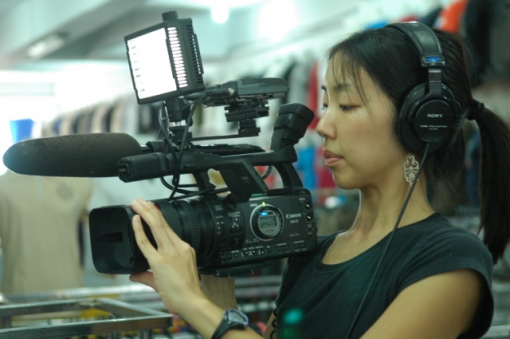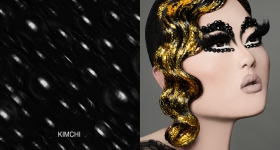Filmmaker Kathy Huang wants to tell you a story. About a competitor in the Miss Chinatown pageant, an Iraq veteran with post-traumatic stress disorder, a teen father from a colonia in the Rio Grande Valley. Whatever the topic, she just wants you to look closer -- and maybe be changed in the process.
Huang’s latest film, Tales of the Waria, follows a community of transgender women who are looking for romance and intimacy in Indonesia, the world’s largest Muslim country. Through their stories, she hopes to challenges your ideas about gender, Islam, and love.
I caught up with the Los Angeles-based documentary film director recently, in advance of the summer screenings of her film.
Who are the warias?
“Waria” is a combination of two Indonesian words -- “wanita,” which means woman, and “pria,” which means man. Basically, a waria is a biological man who believes he was born with the soul of a woman.
Back in 2005, when I was visiting my parents in Taiwan, I opened a newspaper and saw a photograph of a gorgeous waria who had just won a beauty contest in Jakarta. I knew about the “ladyboys” in Thailand. But I had no idea that transgender people could live so openly in Indonesia, a country with a predominately Muslim population. I was riveted.
Warias are accepted in Indonesian society?
As you’d expect, they face a certain level of marginalization and discrimination, especially when they encounter pockets of Islamic radicalism. But warias are also accepted in Indonesian society in a way that most Americans can’t even begin to imagine. You find warias everywhere -- in salons, on television, at weddings, on street corners. Ask someone if they know a waria and they might reply, “Oh, my uncle is a waria.” One of the biggest celebrities in Indonesia, Dorce, is a waria. She’s their equivalent of Oprah.
There’s some cognitive dissonance between the American imagination of Islam and the gender non-conforming expression you capture in the film.
I think a lot of American audiences are surprised by what they see. Sometimes if I tell people about the premise of the film, their eyes widen and they say, “Life must be awful for the warias, with them being Muslim and all.” But the story is never as easy as that. We have this idea in the West that Islam is oppressive and unyielding. But the Islam you see in the film is largely tolerant. It’s not uncommon for warias to be out in the open and even celebrated. It’s the gay community in Indonesia that remains largely in the closet.
Are they considered different communities?
They are distinct. Warias are out in the open -- people know you’re a waria. Whereas if you’re gay, your family most likely doesn’t know about it. You date privately. Tom Boellstorff, an American anthropologist who has been working with queer communities in Indonesia for a long time, has a theory about this kind of sexuality, which is that being gay in Indonesia is an additive identity. It supplements but does not supplant a straight identity. So many people we would consider to be gay men eventually marry women and have children.

Director Kathy Huang
Some of the warias in your movie have what appear to be “straight” boyfriends -- masculine men who date women and waria. Are these men perceived by Indonesian culture as straight? Or does my question still presume a Western taxonomy of sexuality?
It’s more common than you’d think for men to have relationships with warias. I can’t throw around statistics, but in the area I was shooting, young men often turned to warias for their first sexual experiences. These men are not seen as being gay. After all, they’re choosing to be with someone who embodies all the characteristics of a woman.
For the most part, warias perceive themselves to be women searching for their male soulmates. They don’t want to be with biological women, gay men, or other warias. They want a “laki-laki asli” -- a real manly man. But there are always exceptions to this rule. I once met a waria, for example, who was dating a butch lesbian.
So one lesson I learned early on in Indonesia is that putting people and their sexual orientations into categories can be messy and not always worthwhile.
How did you meet your subjects?
I was fortunate. Tom Boellstorff, the anthropologist, introduced me to people in Makassar, which is an area well known for its tolerance of transgender individuals. When I arrived the airport, I was greeted by Tiara, a dynamo of a waria who eventually became an associate producer on the project as well as one of the film’s subjects.
For the first two months I was there, I didn’t even bother filming. I just tried to immerse myself in the waria community. Tiara and I also spent a lot of time driving a van around Makassar and the surrounding villages, looking for film subjects. We must have conducted over 60 pre-interviews. We’d meet warias who’d jump aboard and lead us to other warias. At one point, we were barreling down an unpaved country road in a van full of warias belting out Indonesian love ballads. I’ll treasure this memory until I’m old and gray.
Why did you choose the four individuals you did to follow? Are their experiences representative of the community?
I knew early on that I wanted to capture a spectrum of stories. There are warias who manage to find “husbands,” sometimes even sharing them with biological women. There are warias who live alone. And there’s even a small segment of warias who decide to leave the fold and strike it out as “real” men -- taking on wives and having children. During the casting period of the film, I made sure to keep an eye out for all these different archetypes. I wanted to tell the story of a community.
Your biography sets you outside the community that is your subject: you’re a straight Chinese American woman. How were you perceived?
I think being Asian certainly helped people to relax around me. I didn’t stand out as much, and I was comfortable with a lot of elements of Indonesian culture. But at the same time, the Chinese in Indonesia have had a contentious relationship with other local Indonesians since the time of Dutch colonialism. De facto segregation between the two groups has led to recurrent anti-Chinese riots. When I traveled around with Tiara, she sometimes introduced me to others as being “Korean.” I usually just smiled and stayed quiet.
Was it difficult to convince strangers that you should be permitted to film their private affairs?
For the most part, people were really excited to share their experiences on film. In fact, many warias were upset when I didn’t pick them! The only character who was hesitant was Firman, an “ex-waria” who was trying to live a conventional life -- to be a family man with a wife and kids. He had the most to risk by exposing himself and his story. Ultimately, he decided that he wanted other people to know what he was going through. Out of respect to him and his family, we were very careful about what type of information we presented in the film and how we did so.
What challenges did you face in making this movie?
This was my first feature-length documentary and I can say with great certainty that the most difficult aspect was trying to do everything myself. I was director, producer, camera operator, sound recordist -- all rolled up in one. I quickly learned that shooting and producing, while trying to interpret a foreign language and not offend anybody with any cultural gaffes, can be overwhelming.
It was also somewhat difficult to get funding for this project. I spent a good six months churning out grant proposal after grant proposal and getting rejected from one foundation after another. Those were dark days. Finally, the Independent Television Service stepped in and offered to co-produce the film. Without them, this project wouldn’t have been possible.
Do you think there are any challenges unique to the Asian American filmmaker?
In Hollywood, there are doors to knock on, people that you have to know. The politics involved can filter out Asian Americans. Documentary filmmaking is more democratic. Anyone can pick up a camera and tell a story. You can get farther with talent, hard work, and tenacity. Just look at all the amazing Asian American documentary filmmakers out there: Jessica Yu, Arthur Dong, Ramona Diaz, Renee Tajima Peña.
Your movie certainly doesn’t offer any Hollywood endings.
Finding love is hard -- it’s hard enough when you’re straight and everything in society is conveniently set up for you to meet a partner. Imagine being a marginalized individual who has a limited dating pool and who must also deal with not being accepted by society, your family, and yourself.
I think what’s important here is not necessarily that the particular subjects I’ve chosen have to struggle to find love. It’s that they continue to search for it, at whatever cost. It’s this irrepressible human desire to connect. I find it beautiful and inspiring.
Tales of the Waria is next screening at the Frameline Film Festival in San Francisco on June 18, Outfest in Los Angeles on July 10, and the Asian American International Film Festival in New York in August, date TBD. For more information, see http://www.thewaria.com/
Mandy Hu is a San Francisco-based writer and attorney. She is a friend of the director.









Comments